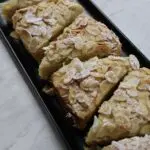
Almond Cake
March 26, 2025If you’ve ever tried making chocolate-dipped strawberries or bonbons at home and ended up with dull, streaky, or blotchy results—don’t worry. You’re not alone. The secret to that shiny chocolate finish, that perfect snap when you bite in, and avoiding those frustrating white streaks (a.k.a. bloom)? It all comes down to one essential technique: tempering chocolate.
In this guide, I’ll walk you through how to temper chocolate—with or without a marble slab—so you can take your chocolate work to the next level.
What is Tempering, Anyway?
Tempering is the process of heating and cooling chocolate in a controlled way to stabilise the cocoa butter crystals. When done correctly, it gives your chocolate that glossy finish, satisfying snap, and makes it resistant to melting at room temperature.
Without tempering, chocolate will set soft, with a dull appearance and uneven texture. Worse still, it may develop bloom—a white, chalky film that looks unappealing and can ruin the texture.
Why Does Tempering Matter?
Whether you’re making filled chocolates, dipping fruit, or coating a dessert, tempered chocolate is what gives you:
A shiny chocolate finish
A clean, crisp snap when broken
Smooth texture and mouthfeel
Resistance to fat or sugar bloom
Better shelf life
At Flux Desserts, we temper every batch of couverture chocolate with precision. It’s part of what makes our bonbons and garnishes stand out—not just in looks, but in flavour and feel.
How to Temper Chocolate at Home (Without Fancy Gear)
You don’t need a professional kitchen or marble slab to get great results. Here’s the simple method I use when working from home:
✦ What You’ll Need:
Good quality couverture chocolate (dark, milk or white)
A heat-proof bowl
A saucepan
A silicone spatula
A food thermometer (essential!)
Optional: Marble slab and scraper
✦ Step-by-Step (Seeding Method – No Marble Required)
Chop and Melt
Chop your chocolate evenly. Melt two-thirds of it gently over a double boiler until it reaches:45–50°C for dark
40–45°C for milk
38–43°C for white
Cool and Seed
Remove from heat. Stir in the remaining one-third of unmelted chocolate. This “seeds” the melted chocolate with stable crystals and helps bring the temperature down to tempering range:31–32°C for dark
29–30°C for milk
28–29°C for white
Test It
Dab a little chocolate on baking paper. It should start setting within a few minutes and look shiny and even.
Tempering With a Marble Slab
If you have a marble or granite slab, even better—this is the traditional method and offers more control.
Melt all the chocolate as above.
Pour two-thirds onto the marble slab and move it around with a scraper and spatula until it cools to around 27°C.
Return the cooled chocolate to the bowl and stir to bring the mixture to the right working temperature.
It’s more effort—but worth it if you’re after professional results every time.
Chef’s Tips for Perfect Results
Use real couverture chocolate, not compound. Look for cocoa butter in the ingredients.
Keep water away—even a drop will seize your chocolate.
Work in a cool, dry space to avoid setting issues.
Use a digital thermometer—guesswork won’t cut it with chocolate.
Troubleshooting Common Chocolate Tempering Issues
| Problem | Possible Causes | Solutions |
|---|---|---|
| Cracks in shell | – Cooling too fast – Shells too thin | – Check cooling temperatures |
| Dull patches on shells | – Over-crystallised chocolate – Fridge too cold – Moulds too cold/damp | – Check cooling – Check tempering temperatures – Warm moulds slightly |
| Couverture not glossy | – Filling too cold – Workspace too cold – Incorrect tempering | – Check filling temperature – Check tempering – Warm workspace |
| Chocolate doesn’t release from moulds | – Under-crystallised – Moulds too warm or greasy – Shells too thin | – Check tempering – Clean and cool moulds – Adjust shell thickness |
| Chocolate too thick to work with | – Over-crystallised – Chocolate too cold | – Heat gently to working temperature |
| White streaks after setting (fat bloom) | – Poor tempering – Incorrect cooling – Storage temperature fluctuating | – Follow tempering temperatures closely – Cool gradually – Store properly |
| White streaks over time | – Incorrect storage temperature – Temperature fluctuations | – Store in a cool, consistent environment |
| Chocolate too runny | – Overheated – Not tempered – No stable crystals present | – Check tempering process – Avoid overheating |
How do you know if its sugar or fat bloom?
Run your finger over the patch. If it melts off; this is a fat bloom as the cocoa butter has separated. Sugar bloom will feel grainy.
Final Thoughts
Mastering how to temper chocolate takes a little practice, but once you’ve got it down, your homemade treats will look and taste worlds better. From shiny chocolate finishes to flawless chocolate shell tips, it’s a skill every aspiring dessert-maker should have.
Want to see tempered chocolate done right? Come by Flux Desserts—or check out our seasonal bonbons, crafted daily with expertly tempered couverture chocolate.

